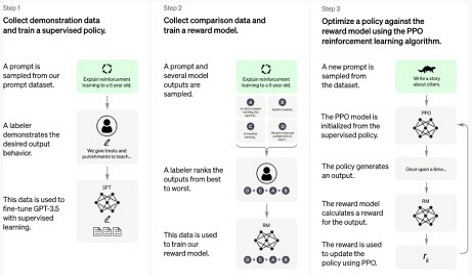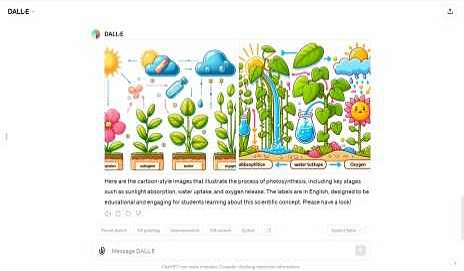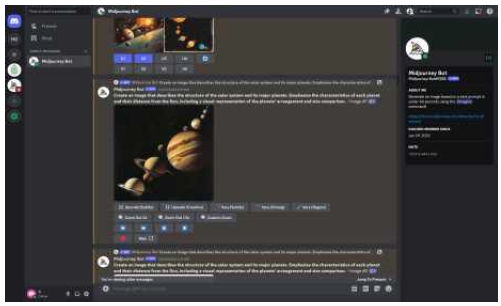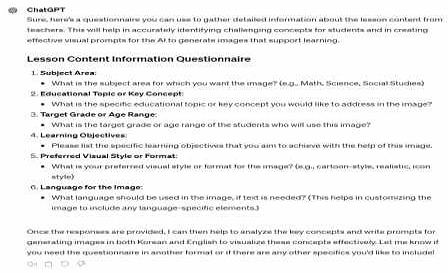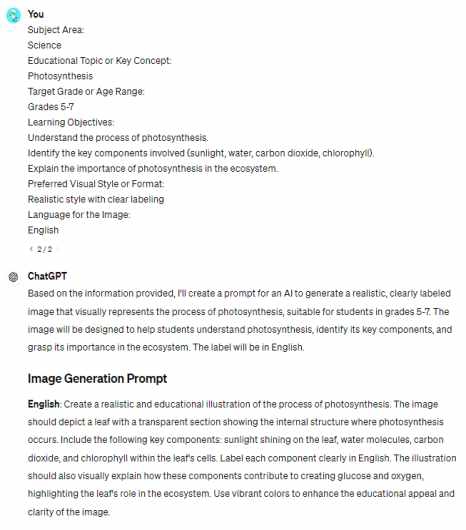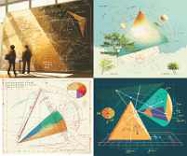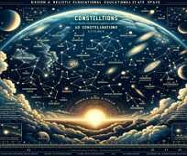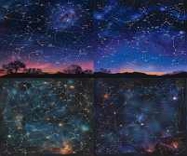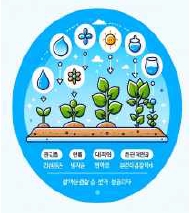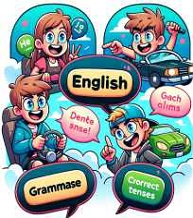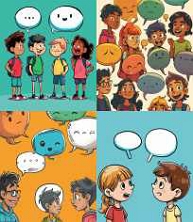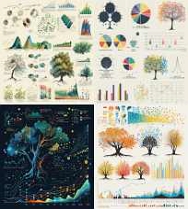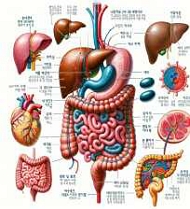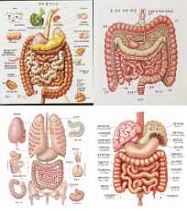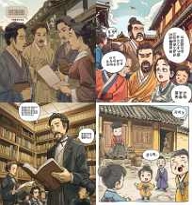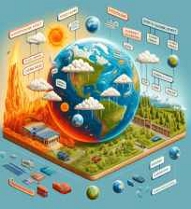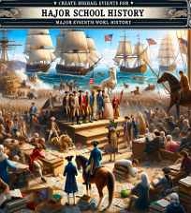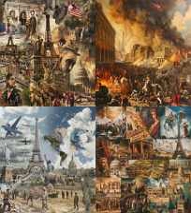
생성형 AI 기반 교수·학습자료 추천 기능 향상을 위한 기법 제안: 질의형 프롬프트 엔지니어링을 중심으로
Copyright ⓒ 2024 The Digital Contents Society
This is an Open Access article distributed under the terms of the Creative Commons Attribution Non-CommercialLicense(http://creativecommons.org/licenses/by-nc/3.0/) which permits unrestricted non-commercial use, distribution, and reproduction in any medium, provided the original work is properly cited.

초록
생성형 AI의 교수·학습자료 추천 기능 향상을 위해 프롬프트 엔지니어링 역량이 강조되고 있지만 이는 여러 어려움이 있다. 이에 본 연구는 교수자가 교수·학습자료 생성을 위한 프롬프트 입력의 용이성 향상을 위해 질의형 프롬프트 엔지니어링 기법을 제안하였다. ChatGPT에서 해당 기법을 활용하여 교수·학습자료 제작을 위한 프롬프트를 작성하였고 그 프롬프트를 Dall-E와 Midjourney에 입력하여 교수·학습자료용 이미지를 제작하였다. 그 결과 교수·학습자료와 관련된 이미지가 생성되었으나 생성형 AI의 Hallucination으로 인해 이미지의 세부적인 표현에 한계가 있음을 파악하였다. 이에 따라 이 문제를 해결하기 위한 후속 연구가 이어지길 기대한다. 향후 2025학년도에 도입될 AI 디지털 교과서에도 생성형 AI를 활용한 교수·학습자료를 제작하는 기법이 도입된다면, 학습 과정에서 이해하기 어려운 개념들을 학습자 스스로 교수·학습 자료를 제작해 보는 활동을 가능하게 하며, 이러한 활동은 학습자의 몰입과 이해를 강화할 기회도 제공할 것이다.
Abstract
Despite the challenges, prompt engineering skills have attracted increasing attention to improve recommendation functions related to teaching and learning materials in generative AI. In response, this study proposes a query-based prompt engineering technique that enables instructors to generate prompts for creating teaching materials easily. By applying this technique in ChatGPT, prompts were first designed before inputting them into Dall-E and Midjourney to generate educational images. While the generated images were relevant to teaching materials, the level of detailed expressions was limited owing to hallucinations in generative AI. Further research is anticipated to address this issue. If generative AI-based methods for creating teaching and learning materials are included in AI digital textbooks planned for 2025, learners will be able to create their own materials for complex concepts. Such activities can enhance learner engagement and understanding.
Keywords:
Generative AI, Prompt Engineering, ChatGPT, Teaching and Learning Materials, Midjourney키워드:
생성형 AI, 프롬프트 엔지니어링, 챗지피티, 교수학습자료, 미드저니Ⅰ. 서 론
1-1 연구 배경 및 목적
2022년 11월, 거대언어모델을 기반으로 한 ChatGPT가 공개되며 대중에게 많은 인기를 끌고, 교육계에서도 ChatGPT를 교육에 어떻게 활용할 수 있을지에 대한 논의가 활발히 이루어졌다[1]. 이에 대한 연구로 생성형 인공지능 시대의 인재상 및 교사의 역할 변화에 대해 고찰하고 이에 따라 OpenAI에서 출시한 ChatGPT와 Dall-E를 영어 교육에 활용하는 방안에 대해 구체적으로 제시한 연구[2], 국어 교사가 ChatGPT를 통해 학생들이 작성한 글에 대한 피드백을 개선할 방안에 대한 연구 및 ChatGPT를 작문 피드백에 올바르게 활용할 수 있는 방안에 대한 연구[3]가 있다. 그뿐만 아니라 ChatGPT와 Stable Diffusion을 활용하여 교수·학습자료용 이미지를 추천하는 프로그램을 구현하였고, 프로그램에 수업 키워드를 입력하여 그와 관련된 교수·학습자료를 추천받는 시도를 한 연구[4]에 이어서 프롬프트 엔지니어링(Prompt Engineering) 기법을 적용하여 교수 학습용 이미지를 제작한 뒤 교사에게 생성형 AI가 제작한 교수 학습용 이미지의 교육적 가치에 대한 평가를 받은 결과 교사 30인은 교육적 가치가 있다고 평가한 연구가 있다. 이 연구에서는 교수·학습자료용 이미지 중 75%의 자료가 학습 목표와 관련이 있었다. 연구 결과로 생성형 AI는 효율적인 교수·학습자료 추천 시스템에 활용할 수 있는 가능성이 도출되었다[5].
그러나 교수자가 생성형 AI를 활용하여 교수자의 의도에 맞는 교수·학습자료를 제작하기에는 여러 어려움이 존재한다. 이에 대한 어려움으로는 프롬프트(Prompt) 입력 및 프롬프트 엔지니어링이 있다. 이때 프롬프트란 “생성형 AI에서 입력되는 정보의 일부분 또는 전체”[2] 이다. 생성형 AI에서 원하는 답변을 얻기 위해서는 프롬프트 엔지니어링을 해야 하는데 프롬프트 엔지니어링을 위해 구체적인 지시, 명확한 조건 제시, 맥락과 예시, 응답의 정도, 맥락과 예시를 제공할 것 등의 기술을 제안한 연구가 있다[6].
이에 본 연구는 교수자가 생성형 AI를 통해 교수·학습자료 제작을 위한 프롬프트 작성 및 프롬프트 엔지니어링을 쉽게 할 수 있도록 ‘질의형 프롬프트 엔지니어링 기법’을 제안하였다. 이를 통해 교수자가 생성형 AI에 프롬프트 엔지니어링에 필요한 수업과 관련된 정보를 입력하여 쉽고 빠르게 프롬프트를 작성하여 교수·학습자료 추천 기능의 활용성을 증대하는 가능성을 탐색하고자 한다.
1-2 선행 연구 및 연구 방법
선행 연구로 ChatGPT와 Stable Diffusion을 활용하여 교수·학습자료용 이미지를 생성하는 것에 대한 가능성을 탐색하였고 생성형 AI가 추천하는 이미지의 종류가 ChatGPT에 의존하고 있다는 한계점을 도출한 연구가 있다[4]. 이어진 연구로 프롬프트 엔지니어링 기법을 적용하여 생성형 AI의 교수·학습자료 생성 성능을 향상하는 연구가 있다. 이 연구의 결과 16개의 자료 중 12개의 자료가 학습 목표와 관련이 있었고, 생성형 AI를 통해 생성된 이미지가 교수·학습자료로써 의미가 있다고 보았다[5].
본 연구는 앞선 연구들에서 연구된 생성형 AI를 활용한 교수·학습자료의 생성에서 그치는 것이 아니라 교수자가 교수·학습자료 생성을 위한 프롬프트 입력의 용이성 향상을 위해 질의형 프롬프트 엔지니어링 기법을 제안하였다. 이 기법을 통해 생성된 프롬프트를 생성하고 Dall-E 3과 Midjourney에 입력하여 생성된 과목별 이미지를 분석해 보고자 한다.
Ⅱ. 주요 개념
2-1 ChatGPT
ChatGPT는 사용자의 질문에 답변하거나, 조언을 제공하고, 특정 주제에 대한 설명을 제공하는 등 다양한 역할을 수행할 수 있다. 이 ChatGPT는 RLHF(Reinforcement Learning from Human Feedback) 즉 ChatGPT의 답변을 인간이 피드백하면 이를 통해 강화 학습하는 방식으로 모델을 훈련하여 ChatGPT의 정확성을 높였다. 그러나 ChatGPT는 그럴듯해 보이지만 무의미한 답변을 작성하는 Hallucination 문제가 생길 수 있어 주의가 필요함을 OpenAI에서 밝혔다[7].
2-2 Dall-E
DALL-E는 텍스트 설명을 기반으로 이미지를 생성하는 OpenAI에서 개발한 인공지능 서비스이다. Dall-E는 간단한 텍스트 입력만으로도 자신만의 독창적인 이미지를 생성할 수 있고 누구나 쉽게 사용할 수 있고 Dall-E를 활용하면 10초 만에 사용자가 입력한 단어를 기반으로 이미지를 생성할 수 있다[8].
2-3 Midjourney
Midjourney는 이미지 생성형 AI로, Dall-E와 유사하게 작동하며, 다양한 스타일과 고유한 시각적 표현을 가능하게 한다. Midjourney는 디스코드에서 프롬프트를 입력하고 이미지를 생성한다는 특징이 있다. 이 Midjourney를 사용하면, 프롬프트를 입력할 줄 모르는 사람들도 고퀄리티의 이미지를 생성할 수 있다[9].
2-4 프롬프트 엔지니어링
프롬프트는 사용자가 제공하는 입력으로, 프롬프트 입력으로 번역, 소설 작성, 코드 생성 등 LLM(Large Language Model)이 다양한 작업을 수행할 수 있게 할 수 있다[10]. 프롬프트를 입력하는 방식에는 제로 샷 프롬프트, 퓨샷 프롬프트 등의 방식이 있는데 이 프롬프트를 작성하는 방법에 따라서 답변의 정확성이 달라질 수 있다. GPT-3를 0, 1, n-shot 프롬프트로 평가한 결과, 더 많은 예제가 제공될수록 성능이 향상되었다. 예제 수에 따른 성능 향상은 예제가 모델에 작업을 수행할 방법을 가르치기보다는 작업을 알려주는 역할을 한다고 볼 수 있다. 단순한 0-shot 프롬프트가 표준 몇 번의 시도 성능을 상회할 수 있음을 발견했으며, 프롬프트 형식을 변경하여 성능을 개선할 수 있다. 또한, 몇 번의 시도 예제로 인한 의미적 오염 효과가 성능 저하를 초래할 수 있음을 발견했다[11]. 생성형 AI 모델들(예: ChatGPT, DALL-E, Midjourney 등)과 비생성형 AI 모델들(예: 전통적인 NLP 모델들) 간의 성능 비교는 프롬프트 엔지니어링의 효과성을 평가하는 데 중요한 역할을 한다. 생성형 AI 모델은 주어진 텍스트 입력을 기반으로 새로운 텍스트를 생성할 수 있는 능력을 가진 모델들이다. 예를 들어, GPT 계열은 읽은 텍스트를 바탕으로 다음 단어를 예측하는 방식으로 작동하며, 주로 자연어 생성(NLG) 작업에 사용된다. 이러한 모델들은 소설 작성, 대화 생성 등 창의적 작업에 유리하다.
반면, 비생성형 AI 모델은 주어진 텍스트를 이해하고 분석하는 데 중점을 둔다. 대표적인 예로 BERT, ROBERTA, ERNIE와 같은 Auto-Encoding(AE) 모델들이 있다. 이 모델들은 입력 텍스트를 부분적으로 마스킹한 후 원래 텍스트를 재구성하는 방식으로 학습된다. 주로 문장 분류 및 시퀀스 라벨링과 같은 자연어 이해(NLU) 작업에 적합하다. 이러한 모델들은 텍스트의 의미를 분석하고 분류하는 작업에 강점을 가진다. 또한, Seq2Seq 모델들은 인코더와 디코더를 모두 사용하여 NLU와 NLG 작업을 통합하여 처리할 수 있는 유연성을 제공한다. 대표적인 모델로는 T5와 mBART가 있다. 이러한 모델들은 번역, 요약 등의 작업에 탁월한 성능을 발휘한다. 각 모델의 강점과 약점을 명확히 이해함으로써, 프롬프트 엔지니어링의 효과성을 평가하고 향상시킬 수 있다[12]. 프롬프트 설계 시에는 애매모호하지 않게 말하기, 편향적이지 않게 말하기, 과도하게 구체적이지 않게 말하기, 배경 정보 제공하기 등 고려해야 할 요소가 있다. 편향적이지 않게 말하기는 명확성을 제공하여 모호성을 줄이고 종종 더 정확한 응답을 도출하는 장점이 있지만 이러한 지시는 모델의 창의성을 제한할 수 있으며 과도하게 제한된 출력으로 이어질 수 있는 단점도 있다[13]. 이렇듯 LLM으로부터 정확한 답변을 얻기 위해 프롬프트를 작성하는 것을 프롬프트 엔지니어링이라고 한다[11]. 프롬프트 엔지니어링 기법 개요는 표 1과 같다[14].
2-5 페르소나 프롬프트 엔지니어링
페르소나 프롬프트 엔지니어링은 ChatGPT를 더 잘 활용하기 위한 프롬프트 엔지니어링 기법의 하나이다. 이는 ChatGPT가 특정 문제에 초점을 맞출 수 있도록 하는 기법이다[15]. 따라서 본 연구에서는 생성형 AI를 활용한 교수·학습자료 생성 과정에서 ChatGPT가 교수·학습자료 제작을 위한 프롬프트 생성에 초점을 맞출 수 있도록 ‘교육전문가’의 역할을 부여하고, 수행해야 하는 역할을 제시하였다.
이때 ChatGPT가 수행하는 역할은 교수자에게 교수·학습자료 생성을 위해 필요한 정보에 관해서 묻는 질문지를 제공하는 것이다. 이에 사용된 프롬프트는 표 2와 같다.
2-6 질의형 프롬프트 엔지니어링
본 연구에서는 프롬프트 엔지니어링을 통한 교수·학습자료 추천 기능 향상을 위한 프롬프트 작성을 위해 필요한 정보 수집을 위하여 질의형 프롬프트 엔지니어링 기법을 제안하였다. 질의형 프롬프트 엔지니어링이란 프롬프트 구성에 필요한 정보를 사용자가 편리하게 입력하게끔 하기 위해 ChatGPT에 질문지를 제공하게 함으로써 프롬프트 구성에 필요한 정보를 입력하고, 그 정보를 바탕으로 프롬프트를 작성하게 하는 방법이다. 이때 교수·학습자료 생성을 위한 프롬프트 작성 질문지는 다음 표 3과 같이구성된다. 이는 교수자로부터 과목 영역, 교육 주제, 연령대, 학습 목표, 시각적 스타일, 언어 등에 대한 질문을 교수자에게 제공하여 이에 대한 정보를 수집한다.
이 정보를 바탕으로 ChatGPT는 교수·학습자료를 위한 프롬프트를 작성하게 된다. 이 기법은 교수자에게 제공된 질문지를 바탕으로 프롬프트 작성에 필요한 정보를 수집하기 때문에 교사의 교육적인 가치를 반영할 수 있다는 이점이 있을 것이다.
Ⅲ. 연구 방법
3-1 ChatGPT를 활용한 프롬프트 엔지니어링을 통한 교수·학습자료 생성 프롬프트 작성
ChatGPT의 성능과 정확도를 높이기 위해 ChatGPT에 역할을 부여하고 세부적인 지시 사항을 입력하는 페르소나 프롬프트 엔지니어링을 하였다. 이를테면 ChatGPT에 교수·학습자료에 전문성이 있는 ‘교육전문가’ 역할을 부여하고 교수자가 질문지를 기반으로 교수·학습자료 추천을 위한 정보를 입력할 수 있게끔 ChatGPT가 질문지를 제공하도록 역할을 부여하였다. 페르소나 프롬프트를 입력했을 때 ChatGPT의 답변은 다음 그림 4와 같다. 이어서 질의형 프롬프트 엔지니어링 기법을 활용하여 교수자가 ChatGPT가 제시한 질문지에 답변하면 그 정보를 바탕으로 ChatGPT가 교수·학습자료 생성을 위한 프롬프트를 작성하게 하였다. 이러한 과정을 통해 교수·학습자료 생성을 위한 프롬프트 작성 과정에서 교수자의 교육적인 가치와 세부적인 수업 내용이 반영되게 하였다. 과목 영역, 교육 주제, 핵심 개념, 학년과 연령대, 학습 목표, 자료의 시각적 스타일, 사용 언어에 답변하면 교수 학습 자료용 Prompt를 작성할 수 있다. 그 결과 작성된 Prompt는 다음 그림 5와 같다.
3-2 이미지 생성 AI를 통한 교수·학습자료 제작
앞서 작성한 프롬프트를 이미지 생성형 AI인 Dall-E와 Midjourney에 입력하여 교수·학습자료 이미지를 생성한 후 이미지를 분석하였다. 이를 통해 질의형 프롬프트 엔지니어링 기법이 교수·학습자료 생성 기능 향상에 영향을 준 것인지, 교사의 프롬프트 엔지니어링에 편리성을 더하였는지에 대해서 연구하였다.
Ⅳ. 연구 결과
4-1 프롬프트 엔지니어링 을 통한 교수·학습자료 생성
본 연구는 교수자가 생성형 AI를 활용한 교수·학습자료 추천 과정에서 교수자가 프롬프트 엔지니어링을 좀 더 쉽게 하기 위한 방안을 마련하고자 했다. 이에 페르소나 프롬프트 엔지니어링 기법과 질의형 프롬프트 엔지니어링 기법을 활용하여 교수·학습자료 생성을 위한 프롬프트를 작성하였다.
교수·학습자료 추천 기능을 향상하기 위하여 ChatGPT에 ‘교육전문가'라는 역할을 부여하였다. 이는 ChatGPT의 성능을 높이는 방법의 하나로, 역할을 부여함으로써 모델이 특정 분야에 대해 보다 전문적인 대응을 할 수 있게 된다. 이는 ChatGPT가 교수·학습자료 생성에 특화된 프롬프트를 작성할 수 있도록 돕는다. 또한, 교수자가 수업 내용을 상세하게 입력할 수 있도록 질문지를 제공하게 하였다. 이를 바탕으로 교수자는 수업 내용에 대해 답변할 수 있다. 질의형 프롬프트 엔지니어링 프롬프트를 ChatGPT에 입력한 결과는 그림 6과 같다.
4-2 질문지를 통한 수업 내용 입력 및 프롬프트 생성
맥락적인 대화를 이어 나가면서, 질문지에 대한 응답을 표 5와 같이 작성했다.
질문지에 대한 응답은 수학, 과학, 사회, 국어 등 다양한 과목으로 하였다. 이 정보를 바탕으로 ChatGPT에게 프롬프트 작성을 요청했을 때 작성되는 프롬프트는 표 6과 같다.
4-3 Dall-E와 Midjourney를 통한 교수·학습자료 생성
앞서 생성한 교수·학습자료 이미지 생성을 위한 프롬프트를 이미지 생성형 AI에 입력하여 교수·학습자료 이미지를 제작하였다. Dall-E 와 Midjourney로 생성한 교수·학습자료 이미지는 다음과 같다. Dall-E는 ChatGPT와 연결되어 있어, 맥락적인 대화를 통한 이미지 생성이 가능하지만, Midjourney는 입력된 프롬프트에만 의존하여 이미지를 생성한다는 특징이 있다. Dall-E와 Midjourney를 통해 생성한 교수·학습자료 이미지는 표 7과 같다. 교수·학습자료용 이미지를 분석했을 때 과학, 사회, 언어 과목에서 교수자의 수업 내용에 대한 답변과 유사한 이미지가 생성되었다. 하지만 이미지에서 부정확한 부분이 있어 교수·학습자료로 사용하면서 교수자의 주의가 필요하다. 이미지가 부정확하게 생성되는 이유는 Hallucination 문제 때문인데, 이때 Hallucination이란 생성형 AI가 무의미하거나 제공된 입력에 충실하지 않은 결과물을 생성하는 것을 말한다[16]. 예를 들어, 과학 시간에 소화기관의 이미지를 생성했을 때 세부적인 요소의 묘사가 잘못된 부분이 생길 수 있고, 국문이 포함된 자료에는 한글 폰트 디자인이 제대로 되지 않는 문제가 발생할 수 있다. 다음 표 7의 그림 7, 8번은 이러한 문제의 예시를 보여준다. 이러한 문제를 보완하기 위해, 생성형 AI가 생성한 교수학습 자료를 사용하기 전에 교사의 검토 및 수정을 필수적으로 포함하는 절차를 제안한다. 또한, 생성형 AI를 활용하여 교수학습 자료를 제작해도 되는 과목과 되지 않는 과목을 분류하는 작업이 필요하다. 예를 들어, 과학 시간에 미토콘드리아의 이미지를 생성할 때 세부적인 요소의 묘사가 잘못된 부분이 생길 수 있으며, 국문이 포함된 자료에서는 한글 폰트 디자인이 제대로 되지 않는 문제가 발생할 수 있다. 이러한 과목별 특성을 고려하여 AI 도구의 사용 여부를 결정하는 것이 중요하다.
분석 결과, Dall-E와 Midjourney가 생성한 이미지 중 수학 과목에 관한 이미지는 부정확한 내용을 포함하고 있는 반면, 과학, 사회, 언어 과목 관련 이미지들은 수업 내용과 유사하여 이들 과목에서 생성형 AI를 활용한 교수·학습자료로 활용할 가능성이 높은 것으로 확인되었다.
하지만 생성형 AI를 활용한 이미지에서의 Hallucination 문제가 발생하고 있어 교사의 이미지 검수 과정이 필요할 것으로 보인다.
Ⅴ. 결 론
이 연구에서는 교수·학습자료용 이미지를 생성하는데 생성형 AI를 활용하고자 하였다. 특히, 교수자가 수업 내용에 관련된 질문지에 답하는 방식을 통해 의도에 부합하는 이미지를 생성할 수 있는 질의형 프롬프트 엔지니어링 기법을 제안하였다. 이 방법은 교수자가 프롬프트를 구체적으로 작성하는 어려움을 해결하는 데 도움이 될 것을 보이고, 결과적으로 수업 내용과 관련된 이미지를 효과적으로 생성할 수 있게 할 것이다. 본 연구에서 생성된 교수·학습자료용 이미지를 분석해봤을 때 과학, 사회, 언어 과목 이미지는 수업 내용과 유사하게 생성되었다. 하지만 생성형 AI의 특성상 Hallucination 문제가 발생하여 부정확한 이미지가 생성될 수 있어 생성형 AI로 생성한 이미지에 대해 교사의 검토가 필수적일 것으로 보인다. 이때 Hallucination이란 생성된 콘텐츠가 주어진 입력과는 다른 현상을 말한다[16]. 이에 따라 생성형 AI를 활용한 교수·학습자료 생성 과정에서의 Hallucination 문제를 해결하기 위한 후속 연구가 필요할 것으로 보이고 이를 해결하기 위해 생성형 AI가 생성한 교수·학습 자료 이미지의 정확성을 교사가 반드시 검토해야 한다. 또한 실제 교육 현장에서 생성형 AI를 효과적으로 활용하기 위해 교사들을 대상으로 생성형 AI 사용법 및 검토, 수정 방법에 대한 교육이 필요하다. 이러한 교수·학습자료용 이미지 제작에 ChatGPT와 이미지 생성형 AI를 활용하는 것은 교수자와 학습자 모두에게 유익하다. 교과목 학습 과정에서 학습자가 모르는 개념을 직접 생성해 보는 활동은 디지털 학습 역량을 강화하며, 보다 실질적인 학습 경험을 제공할 것이다. 2023년 교육부 업무 보고에 따르면, 2025학년도 인공지능 (AI) 기반 디지털 교과서 도입이 주요 과제로 제시되었다[17]. 이와 관련하여 본 연구에서 사용된 교수·학습자료용 이미지를 생성하는 기능이 인공지능 (AI) 기반 디지털 교과서에 추가된다면 이는 디지털 학습 역량 강화에 도움이 될 것으로 기대된다.
Acknowledgments
본 연구는 동아대학교 교내연구비 지원으로 연구되었습니다.
References
-
J. Shin, P. Park, and Y. Bae, “The Impact of Prompt Engineering Education on Attitudes of Elementary School Students toward AI,” Journal of the Korean Association of Information Education, Vol. 27, No. 5, pp. 635-644, October 2023.
[https://doi.org/10.14352/jkaie.2023.27.5.635]

- Y. Hwang, “The Emergence of Generative AI and PROMPT Literacy: Focusing on the Use of ChatGPT and DALL-E for English Education,” Journal of the Korea English Education Society, Vol. 22, No. 2, pp. 263-288, May 2023.
-
S.-K. Choi, “A Case Study on the Experience of Korean Language Teachers in Providing Writing Feedback Using ChatGPT,” Korean Journal of Teacher Education, Vol. 40, No. 1, pp. 379-404, January 2024.
[https://doi.org/10.14333/KJTE.2024.40.1.16]

-
S.-H. Lee and K.-S. Song, “Exploring the Possibility of using ChatGPT and Stable Diffusion as a Tool to Recommend Picture Materials for Teaching and Learning,” Journal of the Korea Society of Computer and Information, Vol. 28, No. 4, pp. 209-216, April 2023.
[https://doi.org/10.9708/jksci.2023.28.04.209]

-
S.-H. Lee and K.-S. Song, “Prompt Engineering to Improve the Performance of Teaching and Learning Materials Recommendation of Generative Artificial Intelligence,” Journal of the Korea Society of Computer and Information, Vol. 28, No. 8, pp. 195-204, August 2023.
[https://doi.org/10.9708/jksci.2023.28.08.195]

-
S. Ekin, “Prompt Engineering for ChatGPT: A Quick Guide to Techniques, Tips, and Best Practices,” Authorea Preprints, 2023.
[https://doi.org/10.36227/techrxiv.22683919.v2]

- OpenAI. Introducing ChatGPT [Internet]. Available: https://openai.com/index/chatgpt/, .
-
H. Park, “A Case Study on Application of Text to Image Generator AI DALL·E,” A Treatise on the Plastic Media, Vol. 26, No. 1, pp. 102-110, February 2023.
[https://doi.org/10.35280/KOTPM.2023.26.1.11]

-
D.-H. Kwon, “Analysis of Prompt Elements and Use Cases in Image-Generating AI: Focusing on Midjourney, Stable Diffusion, Firefly, DALL·E,” Journal of Digital Contents Society, Vol. 25, No. 2, pp. 341-354, February 2024.
[https://doi.org/10.9728/dcs.2024.25.2.341]

-
J. Ellen, K. Olson, E. Toh, A. Molina, A. Donsbach, M. Terry, and C. J. Cai, “Promptmaker: Prompt-based Prototyping with Large Language Models,” in Proceedings of CHI '22: CHI Conference on Human Factors in Computing Systems, New Orleans: LA, pp. 1-8, April-May 2022.
[https://doi.org/10.1145/3491101.3503564]

-
L. Reynolds and K. McDonell, “Prompt Programming for Large Language Models: Beyond the Few-Shot Paradigm,” in Proceedings of CHI Conference on Human Factors in Computing Systems, Yokohama, Japan, pp. 1-7, May 2021.
[https://doi.org/10.1145/3411763.3451760]

-
H. Zhang, H. Song, S. Li, M. Zhou, and D. Song, “A Survey of Controllable Text Generation using Transformer-based Pre-trained Language Models,” ACM Computing Surveys, Vol. 56, No. 3, pp. 1-37, October 2023.
[https://doi.org/10.1145/3617680]

-
L. Giray, “Prompt Engineering with ChatGPT: A Guide for Academic Writers,” Annals of Biomedical Engineering, Vol. 51, pp. 2629-2633 June 2023.
[https://doi.org/10.1007/s10439-023-03272-4]

-
S. Park and J. Kang, “Analysis of Prompt Engineering Methodologies and Research Status to Improve Inference Capability of ChatGPT and Other Large Language Models,” Journal of Intelligence and Information Systems, Vol. 29, No. 4, pp. 287-308, December 2023.
[https://doi.org/10.13088/jiis.2023.29.4.287]

-
W. C. Shim, H. B. Jin, S. J. Kim, and S. D. Kim, “The Possibility of Prompt Engineering for ARC Problem Solving,” KIISE Transactions on Computing Practices, Vol. 30, No. 2, pp. 63-69, February 2024.
[https://doi.org/10.5626/KTCP.2024.30.2.063]

-
Z. Ji, N. Lee, R. Frieske, T. Yu, D. Su, Y. Xu, ... and P. Fung, “Survey of Hallucination in Natural Language Generation,” ACM Computing Surveys, Vol. 55, No. 12, pp 1-38, March 2023.
[https://doi.org/10.1145/3571730]

- Republic of Korea Policy Briefing. Hold Digital Education Vision Declaration Ceremony and Conference [Internet]. Available: http://www.korea.kr/briefing/pressReleaseView.do?newsId=156554106, .
저자소개

2020년~현 재: 동아대학교 교육학과 학사과정
※관심분야:인공지능, 인공지능 활용 교육, Chatgpt 등

2021년 8월:부산대학교 대학원(교육학박사)
2023년~현 재 : 동아대학교 산학협력단 조교수
※관심분야:AI 리터러시, 프롬프트 엔지니어링, AI 활용 교육 등
